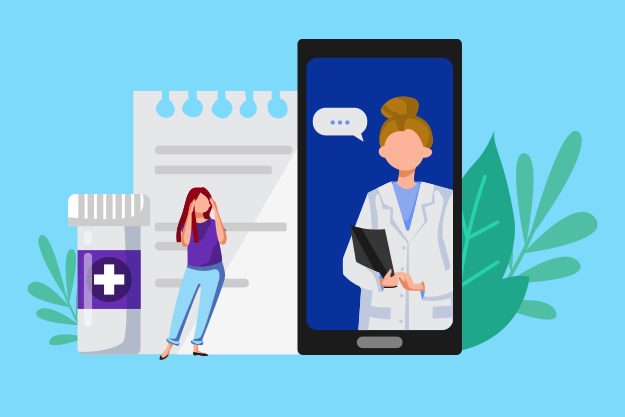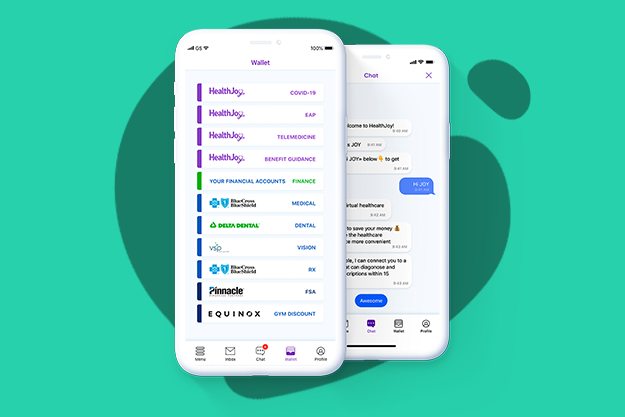Better Benefits Communication is Key to Helping Employees Manage Care
During the pandemic, we heard a lot about the harmful effects of delayed care. Employees who were afraid to see their doctors in person skipped...
Connected Navigation Platform
Guiding to high-value care
Behavioral Health
Foster a mentally healthy workplace
EAP
Supporting holistic wellbeing
Virtual MSK Care
Reimagining musculoskeletal care
Virtual Primary Care
Powered by smart navigation
Surgery Centers of Excellence
Best-in-class surgical outcomes
Virtual Urgent Care
Immediate care, any hour of the day
Chronic Care
A new approach to chronic care
Integrations
Flexible to any strategy
4 min read
 Claire Wiseman Imber
:
September 29, 2021
Claire Wiseman Imber
:
September 29, 2021

As you review your benefits education strategy, what old standouts seem too important to replace? Your strategy probably still includes favorites like benefits booklets, presentations, or flyers. Perhaps this year, you’ve decided to host these materials online — but you definitely wouldn’t cut them altogether, right?
Emailing a PDF or hosting a presentation won’t suddenly help employees “get” their benefits. These strategies aren’t reimagined — they’re simply transferred online. If presentations and booklets worked (in any form), you’d spend less of your week answering benefits questions.
Something’s not working, and the answer isn’t simply digital.
Let’s talk about the biggest challenges when it comes to benefits education in general.
Let’s be honest: benefits booklets are an outdated method of communicating employee benefits. Unfortunately, we know they’re also a key tool many HR pros are reluctant to part with. After all, without a booklet, where will employees turn for answers?
We have some thoughts. But first, let’s review exactly how benefits booklets fall short.
First, employees aren’t happy with the status quo. Our 2021 Employee Benefits Insights Survey revealed that human resources’ current strategies don’t align with employees’ preferences. Although more than half of employees said they turn to their benefits guide whenever they have a question, it’s not how they want to view their benefits information. Instead, employees told us they prefer apps (28%) and email (23%).
Second, benefits booklets aren’t really doing their jobs. It’s a resource that may be full of valuable information, but that knowledge gets lost within the sea of jargon, complicated explanations, and confusing acronyms. One survey found that only 32% of people could correctly define insurance terms like “out-of-pocket,” “deductible,” and “copay,” while 38% knew all three terms. Navigating healthcare is complicated enough, but if employees don’t understand their benefits, then how can we expect them to make smarter healthcare decisions?
Third and finally, a benefit booklet does nothing to promote your engagement goals year-round. A paper pamphlet can't draw them back to underutilized cost-saving benefits in February, March, and beyond. That makes “I’ll just ask my HR representative” a much more appealing alternative — that is, if they ask at all.
Simply creating a digital version of your benefits booklet isn’t enough. Sure, they might be easier to save on your employees’ desktops and therefore slightly less likely to be tossed in the trash. Even PDF booklets, though, fall short in one key area: they can’t help employees in the exact moment they need to make healthcare decisions.
In the worst-case scenario, employees don’t even come to you with questions. Instead, they’ll delay necessary care because they’re unsure about coverage, and avoid taking prescriptions because of worry over cost. In our 2021 report, 40% said they avoided care in the last year because they don’t know what is covered. Twenty-nine percent had avoided taking medication as prescribed because of cost. Though older employees were more worried about costs, they were less likely to delay care. Lack of benefits understanding continues to fuel fear — forcing employees to make hurried and high-cost healthcare decisions that leave them unhappy.
Like benefits booklets, benefits presentations also seem like a can’t-be-skipped component of your benefits education strategy. But this messaging hasn’t kept pace with the times. When bite-sized information and 20-second TikTok videos are the order of the day, how can you expect employees to stay engaged with a 60-minute benefits presentation?
Ultimately, presentations are just as static as benefits booklets. Sure, you may make a presentation available on your company’s cloud. How often will employees access that information? More often than not, benefits presentations flash employees a bit of information about their benefit plan and then leave them wondering how to use them. Just like the booklets, they fall short.
Look, we know that introducing employees to their benefits is essential, especially during OE. Without a presentation, you may leave your employees wondering what to expect from open enrollment or even the year ahead. There’s value in improving your presentations, shortening their length for maximum engagement, and not relying on them as a source of truth
There’s also value in streamlining your benefits education efforts. Given that these two major players fall short, you need a new solution: a tool that fills the gaping hole left by your benefits presentation’s last slide.
A better solution centralizes everything in one place, from your individual, siloed benefits to the education you need to drive their utilization. It’s built on an idea we don’t think has quite caught on: that creating better healthcare consumers isn’t just about education, but decision support. It recognizes that your benefits education strategy takes a lot of time and effort, and makes all that effort more impactful.
The right alternative to a benefits booklet is a platform that brings all those threads together to create a connected care experience — one that helps people make smarter healthcare decisions and achieve better healthcare outcomes. It can also:
With a navigation platform in your back pocket, employees no longer need to flip through their booklet for details on coverage. In fact, you might decide to **gasp** toss it altogether.
Employees can easily follow up on your presentation without digging for links. Hardworking benefits presentations aren’t a total waste of time. You’ll find HR departments that see a 50%+ decrease in benefits questions after launch.
Since the advent of the pandemic, it's likely you’ve already had to re-evaluate how you deliver benefits education. With access and education always on their mobile device, you no longer need to worry that a dispersed worker will be left out of the loop.
In the early months of 2020, data shows patient usage increased 33% over the previous year. And the future for telemedicine remains promising, especially with a boom in funding and a global market expected to reach $396.76 billion by 2027. Its resurgence, however, doesn’t necessarily make the technology easier to use. Virtual healthcare needs to be accessible, and when all your benefits are centralized in a single app, navigation is as simple as a few taps.
Launching a new benefit or service? Kicking off a wellness initiative? Need to remind people about OE or scheduling that flu shot? With push notification capabilities, a benefits navigation platform enables you to reach out to employees efficiently and with ease on their mobile devices. At HealthJoy, employers have access to a self-service tool called Broadcaster, which enables them to deliver custom or templated in-app communications whenever they want.
Adding a navigation platform doesn’t have to mean rethinking your entire benefit education strategy. In fact, it may work best when it grows from the educational foundation you’ve worked hard to build. We’re not talking about tossing all your plans or even killing your benefits booklet (yet). Instead, we’re offering a solution that follows up your OE efforts with year-round engagement and personalized support. In other words, it makes all your benefits education more meaningful.
This post was originally published in August 2020 and updated in 2022.

During the pandemic, we heard a lot about the harmful effects of delayed care. Employees who were afraid to see their doctors in person skipped...

1 min read
Building a genuinely satisfying employee benefits package is at the top of every HR professional’s mind, but getting there is harder than ever...

What makes it so easy to use a service like Amazon? There are a number of reasons: you can access product offerings in one place, filter for cost...